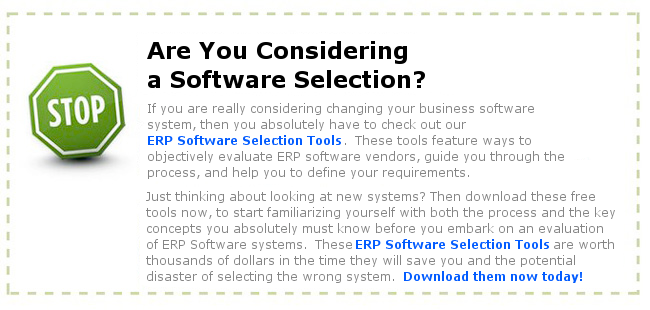Veronica Fredriksen
This DeveloperEye.com market study gives an overview of the ERP applications market, the key players as well as the benefits and obstacles with implementation of an ERP solution.
London, UK (PRWEB) March 31, 2005 — In general, Enterprise Resource Planning (ERP) software attempts to integrate all departments and functions across a company onto a single computer system that can serve all those different departments’ particular needs.
ERP combines all departments within an organisation (HR, Manufacturing) together into a single, integrated software program that runs off a single database. In turn, the various departments can more easily share information and communicate with each other.
When one department finishes with an order, it is automatically routed via the ERP system to the next department. To find out where the order is at any point, you need only log in to the ERP system and track it down.
Segments within the ERP software Market
The ERP applications market falls into three primary segments by customer size: Enterprises, Mid-Market and Small Companies. The major ERP application vendors to each segment group is illustrated below:
Market Segment ERP Vendors
Enterprises:
SAP, Oracle/PeopleSoft
Upper Mid-Market:
Microsoft, Lawson, SSA Global, Geac, SAP, Oracle/PeopleSoft
Lower Mid-Market: Microsoft, Epicor, Exacta, Sage, NetSuite, SPA BusinessOne
Small Companies: Sage, Intuit, ACCPAC, NetSuite
Key Players
SAP is the market leader in the ERP applications market. SAP and Oracle have been in intense competition for customers in recent years. After Oracle’s acquisition of PeopleSoft, they are now ranked as the second leader of the ERP software market. SAP is holding the leadership within vertical sectors such as Government, Financial Services, Healthcare and Education across the European countries.
When looking at the leading ERP vendors for the European countries, SAP is the market leader in Germany, Spain and Italy. Oracle, on the other hand, has a strong market leadership in certain segments within the UK and France.
Most industry analysts are watching i2 Technologies, Siebel Systems, Broadvision, Ariba and CommerceOne as ERP solution providers that would like to have their share of the market.
In addition, there are also predictions that the ERP battle amongst ERP solution providers will move rapidly to the mid-market as Microsoft begins to actively compete with vendors such as SAP and Oracle for market share.
Benefits of implementation of ERP solutions
Integrate financial information – To avoid receiving conflicting information from the Finance-, HR- or Manufacturing Department, the ERP system creates a single version of the truth that cannot be questioned because everyone is using the same system.
Integrate customer order information – ERP systems can become the place where the customer order lives from the time a customer service representative receives it until the loading dock ships the merchandise and finance sends an invoice. By having this information in one software system, organisations can keep track of orders more easily, and coordinate manufacturing, inventory and shipping among many different locations at the same time.
Standardize and speed up manufacturing processes –
Standardizing a company’s processes using a single, integrated computer system can save time, increase productivity and reduce head count.
Reduce inventory – ERP helps the business process flow more smoothly, and it improves visibility of the order fulfilment process inside the company. In turn, this may lead to reduced inventories of the stuff used to make products (work-in-progress inventory).
Standardize HR information – Especially in companies with multiple business units, HR may not have a unified, simple method for tracking employees’ time and communicating with them about benefits and services.
ERP software challenges
·There is often a gap between package functionality and business needs
·ERP environments are costly to maintain
·ERP Implementation is costly and time consuming
·Larger companies typically have multiple ERP packages and vendors
·Integration of systems is complex
·Companies Are Simplifying Their ERP Environments
About DeveloperEye.com
DeveloperEye.com is the premiere online resource for the European application development and IT infrastructure communities. Localized news and events information coupled with technical articles, informed editorial and market studies make the portal and its associated offerings make Developer.Eye.com the ideal multilingual information resource center. For further information, please visit www.DeveloperEye.com.
http://www.developereye.com
